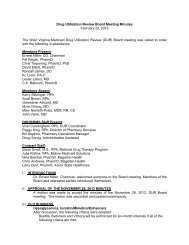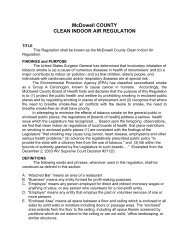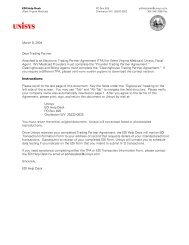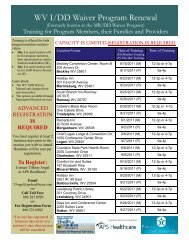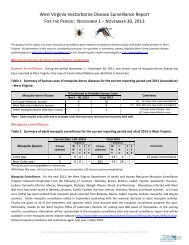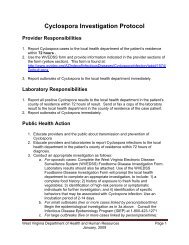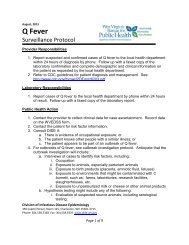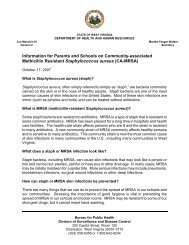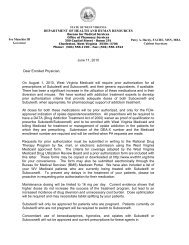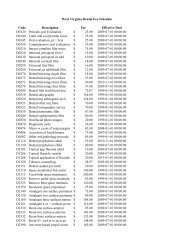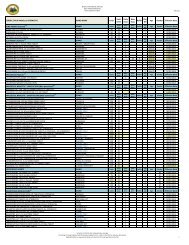CDC Surveillance Manual for Poliomyelitis - DHHR
CDC Surveillance Manual for Poliomyelitis - DHHR
CDC Surveillance Manual for Poliomyelitis - DHHR
Create successful ePaper yourself
Turn your PDF publications into a flip-book with our unique Google optimized e-Paper software.
VPD <strong>Surveillance</strong> <strong>Manual</strong>, 3 rd Edition, 2002Chapter 10, <strong>Poliomyelitis</strong>: 10 - 2(ACIP) recommended changing to a sequential polio immunization schedulethat included 2 doses of OPV, followed by 2 doses of inactivated poliovaccine, IPV. 2 VAPP occurred less frequently under this schedule, and in2000, this recommendation was updated to a schedule of all IPV. 3,4,5 OPV isno longer manufactured or available in the U.S.The last U.S. cases of indigenously transmitted wild poliovirus disease werereported in 1979. Since then, apart from six cases of imported poliomyelitis,only one of which has occurred since 1986, all reported cases of paralyticpoliomyelitis in the United States have been vaccine-associated (see Figure1). 6, 7 VAPP was a very rare disease, with an average of eight reportedcases annually during 1980–1999, or one case reported <strong>for</strong> every 2.4 milliondoses of OPV distributed. 6, 7 The risk of VAPP is highest following the firstdose of OPV and among immunodeficient persons. Since changing to anall-IPV immunization schedule in 2000, there have been no cases of VAPPreported in the U.S.161412Vaccine -AssociatedAll Year Total10Cases8642019851986198719881989199019911992199319941995199619971998199920002001YearFigure 1: Total number of reported paralytic poliomyelitis cases(including imported cases) and number of reported vaccine-associatedcases—United States, 1985–2001Following the successful implementation of the polio eradication initiative inthe Americas beginning in 1985, the last case of wild poliovirus-associateddisease was detected in Peru in 1991. The hemisphere was certified as freeof indigenous wild poliovirus in 1994. 8 In 1988, the World Health Assemblyadopted the goal of worldwide eradication of poliomyelitis by the year 2000. 9By 2001, substantial progress toward eradication has been reported: a morethan 99% decrease in the number of reported cases of poliomyelitis wasachieved; all polio-endemic and recently endemic countries have conductedNational Immunization Days and established sensitive surveillance systems<strong>for</strong> acute flaccid paralysis. Wild polioviruses continue to be isolated from justseven countries: Afghanistan, India, and Pakistan in Asia, and Egypt, Niger,Nigeria, and Somalia in Africa. 10 Due to the successful implementation of
VPD <strong>Surveillance</strong> <strong>Manual</strong>, 3 rd Edition, 2002Chapter 10, <strong>Poliomyelitis</strong>: 10 - 3the global poliomyelitis eradication initiative, the risk of importation of wildpolio virus into the United States decreased substantially over the lastdecade. Nevertheless, the potential <strong>for</strong> importation of wild poliovirus into theUnited States remains until worldwide poliomyelitis eradication is achieved.Because inapparent infection with wild virus strains no longer contributes toestablishing or maintaining poliovirus immunity in the United States,universal vaccination of infants and children is the only means ofestablishing and maintaining population immunity against poliovirus toprevent poliomyelitis cases and epidemics caused by importation of wildvirus into the United States.Population-based surveys have confirmed that the prevalence of poliovirusantibodies among school-age children, adolescents, and young adults in theUnited States is high (> 90% to poliovirus types 1 and 2, and > 85% to type3). 11,12 In addition, seroprevalence surveys conducted in two inner-city areasof the United States (areas in which routine coverage was low) during 1990–1991 found that > 80% of all children 12–47 months of age had antibodies toall three poliovirus serotypes. 13 More recent data also demonstrate a highseroprevalence of antibody to all poliovirus serotypes among children aged19–35 months who lived in the inner-city areas of four cities in the UnitedStates, with 96.8%, 99.8%, and 94.5% seropositive to poliovirus types 1,2,and 3, respectively. 14 However, members of certain religious groupsobjecting to vaccination have remained susceptible to poliomyelitis. Thesegroups appear to be highest risk <strong>for</strong> epidemic poliomyelitis. The last twooutbreaks of poliomyelitis in the United States were reported amongreligious groups—in 1972 among Christian Scientists 15 and in 1979 amongthe Amish. 1Since 1999, there have been a few poliomyelitis outbreaks caused byvaccine-derived polioviruses. 16, 17, 18 These outbreaks have occurred inregions where OPV is being used and overall polio vaccination rates are low.The vaccine polioviruses are able to replicate unchecked in the guts ofinadequately immunized persons, until regaining some of the infectiousfeatures of wild polioviruses. Clinical disease caused by these vaccinederivedviruses is indistinguishable from that caused by wild polioviruses.Outbreak control measures in these outbreaks rely upon vaccination withOPV.One such outbreak of vaccine-derived type 1 OPV strain poliomyelitisoccurred in the Dominican Republic (13 confirmed cases) and Haiti (8confirmed cases, including 2 fatal cases), during 2000-2001. 16 Twenty ofthese cases occurred in unvaccinated or incompletely vaccinated cases, andall cases occurred in communities with very low (7%–40%) rates of coveragewith OPV. The infecting vaccine-derived poliovirus strain was geneticallytraced back to OPV administered 1998–1999 and had biological propertiesindistinguishable from those of wild polioviruses. The World HealthOrganization assisted the National Ministries of Health in conducting OPVimmunization campaigns in both countries; the campaigns successfullycontained the outbreak. Other vaccine-derived poliomyelitis outbreaks haverecently occurred in the Philippines 17 and Madagascar. 18 In all 3 outbreaks,the presumed risk factors <strong>for</strong> the outbreak included gaps in OPV coverageand absence of circulating wild poliovirus.
VPD <strong>Surveillance</strong> <strong>Manual</strong>, 3 rd Edition, 2002Chapter 10, <strong>Poliomyelitis</strong>: 10 - 4III.Importance of rapid identificationRapid investigation of suspected poliomyelitis cases is critical to identifyingpossible wild poliovirus transmission. Rapid detection of wild virusassociatedcases permits the timely implementation of controls to limit thespread of imported wild poliovirus and maintain the eradication of wildpoliovirus in the United States. Moreover, rapid investigation of suspectedcases will allow collection of specimens <strong>for</strong> poliovirus isolation, which iscritical <strong>for</strong> ruling out or confirming paralytic poliomyelitis, whether wild virusassociatedor vaccine-related.IV.Importance of surveillanceThe poliomyelitis surveillance system serves to 1) detect importation of wildpoliovirus into the U.S. and 2) detect the presence of vaccine-derivedpoliovirus in the U.S.V. Disease reduction goalsNo cases of paralytic polio due to indigenously acquired wild poliovirus havebeen reported in the United States since 1979. The goal of maintainingelimination of paralytic poliomyelitis due to indigenous acquisition of wildpoliovirus has been established <strong>for</strong> each year until the goal of globaleradication is met. 16 There have been no reported cases of vaccine-derivedparalytic polio in the U.S.VI.Case definitionThe following case definition <strong>for</strong> paralytic poliomyelitis has been approved bythe Council of State and Territorial Epidemiologists (CSTE), and waspublished in 1997. 20Clinical case definitionAcute onset of a flaccid paralysis of one or more limbs with decreased orabsent tendon reflexes in the affected limbs, without other apparent cause,and without sensory or cognitive loss.Case classificationProbable: A case that meets the clinical case definition.
VPD <strong>Surveillance</strong> <strong>Manual</strong>, 3 rd Edition, 2002Chapter 10, <strong>Poliomyelitis</strong>: 10 - 5Confirmed: A case that meets the clinical case definition and in which thepatient has a neurologic deficit 60 days after onset of initial symptoms, hasdied, or has unknown follow-up status.Comment: All suspected cases of paralytic poliomyelitis are reviewed by apanel of expert consultants be<strong>for</strong>e final classification occurs. Confirmedcases are then further classified based on epidemiologic and laboratorycriteria. Only confirmed cases are included in Table 1 in the Morbidity andMortality Weekly Report (MMWR). 20Suspected cases under investigation are enumerated in a footnote to thequarterly immunization table of the MMWR. 20Confirmed cases are further classified based on epidemiologic andlaboratory criteria. 18Indigenous case: Any case which cannot be proved to be imported.Imported case: A case which has its source outside the United States. Aperson with poliomyelitis (United States resident or other) who has enteredthe United States and had onset of illness within 30 days be<strong>for</strong>e or afterentry. 18VII. Laboratory testingTo increase theprobability ofpoliovirus isolation,at least two stoolspecimens shouldbe obtained 24hours apart frompatients withsuspectedpoliomyelitis asearly in the courseof disease aspossible (ideallywithin 15 days afteronset).Laboratory studies, especially attempted poliovirus isolation, are critical torule out or confirm the diagnosis of paralytic poliomyelitis.For additional in<strong>for</strong>mation on laboratory support <strong>for</strong> surveillance of vaccinepreventablediseases, see Chapter 19, “Laboratory Support <strong>for</strong> <strong>Surveillance</strong>of Vaccine-Preventable Diseases.”Virus isolationThe likelihood of poliovirus isolation is highest from stool specimens,intermediate from pharyngeal swabs, and very low from blood or spinal fluid.The isolation of poliovirus from stool specimens contributes to the diagnosticevaluation but does not constitute proof of a causal association of suchviruses with paralytic poliomyelitis. 1 Isolation of virus from the cerebrospinalfluid (CSF) is diagnostic but is rarely accomplished. To increase theprobability of poliovirus isolation, at least two stool specimens and two throatswabs should be obtained 24 hours apart from patients with suspectedpoliomyelitis as early in the course of the disease as possible (i.e.,immediately after poliomyelitis is considered as a possible differentialdiagnosis), but ideally within the first 14 days after onset of paralytic disease.Specimens should be sent to the state or other reference laboratories <strong>for</strong>primary isolation. Laboratories should <strong>for</strong>ward isolates to <strong>CDC</strong> <strong>for</strong> intratypicdifferentiation to determine whether the poliovirus isolate is wild or vaccinederived.
VPD <strong>Surveillance</strong> <strong>Manual</strong>, 3 rd Edition, 2002Chapter 10, <strong>Poliomyelitis</strong>: 10 - 6Isolation of wild poliovirus constitutes a public health emergency andappropriate control ef<strong>for</strong>ts must be initiated immediately (in consultationamong health-care providers, the state and local health departments, and<strong>CDC</strong>).Serologic testingSerology may be helpful in supporting or ruling out the diagnosis of paralyticpoliomyelitis. An acute serum specimen should be obtained as early in thecourse of disease as possible, and a convalescent specimen should beobtained at least 3 weeks later. A four-fold titer rise between the acute andconvalescent specimens suggests poliovirus infection. Non-detectableantibody titers in both specimens may help rule out poliomyelitis but may befalsely negative in immunocompromised persons, who are also at highestrisk <strong>for</strong> paralytic poliomyelitis. In addition, neutralizing antibodies appearearly and may be at high levels by the time the patient is hospitalized; thus,a four-fold rise may not be demonstrated. Vaccinated individuals would alsobe expected to have measurable titers; there<strong>for</strong>e vaccination history isimportant <strong>for</strong> serology interpretation. One of the limitations of serology is theinability to distinguish between antibody induced by vaccine-relatedpoliovirus and antibody induced by wild virus. Serologic assays to detectanti-poliovirus antibodies are available in most commercial and state publichealth laboratories.Cerebrospinal fluid (CSF) analysisThe cerebrospinal fluid usually contains an increased number ofleukocytes—from 10 to 200 cells/mm 3 (primarily lymphocytes) and a mildlyelevated protein, from 40 to 50 mg/100 ml. These findings are non-specificand may result from a variety of infectious and noninfectious conditions.VIII. ReportingEach state and territory has regulations or laws governing the reporting ofdiseases and conditions of public health importance. 22 These regulationsand laws list the diseases to be reported and describe those persons orgroups responsible <strong>for</strong> reporting, such as health-care providers, hospitals,laboratories, schools, daycare and childcare facilities, and other institutions.Contact your state health department <strong>for</strong> reporting requirements in yourstate.Reporting to <strong>CDC</strong>Because poliomyelitis no longer exists in the U.S. (no cases since 1999),each reported case of suspected poliomyelitis should be followed up by localand state health departments in close collaboration with <strong>CDC</strong>. At thedirection of the state health department, <strong>CDC</strong> (National ImmunizationProgram, 404-639-8255) will provide consultation regarding the collection ofappropriate clinical specimens <strong>for</strong> virus isolation and serology, the initiation
VPD <strong>Surveillance</strong> <strong>Manual</strong>, 3 rd Edition, 2002Chapter 10, <strong>Poliomyelitis</strong>: 10 - 7of appropriate consultations and procedures to rule out or confirmpoliomyelitis, the compilation of medical records, and most importantly, theevaluation of the likelihood that the disease may be caused by wildpoliovirus.In<strong>for</strong>mation to collectDemographic, clinical, and epidemiologic in<strong>for</strong>mation are collected to:• Determine whether the suspected case meets the case definition <strong>for</strong>paralytic poliomyelitis• Determine whether the disease may be caused by wild poliovirus or isvaccine-relatedThe following data elements are epidemiologically important and should becollected in the course of a case investigation. See Appendix 14 <strong>for</strong> detailson each data category. Additional in<strong>for</strong>mation may be collected at thedirection of the state health department or <strong>CDC</strong>.• Demographic in<strong>for</strong>mation− Name− Address− Date of birth− Age− Sex− Ethnicity− Race− Country of birth− Length of time in U.S.• Reporting source− County− Earliest date reported• Clinical− Hospitalizations: dates and duration of stay− Date of onset of symptoms− Complications− Immunologic status of case-patient− Outcome (case survived or died)· Date of death· Postmortem examination results· Death certificate diagnoses• Laboratory− Serologic testcontinued on the next page
VPD <strong>Surveillance</strong> <strong>Manual</strong>, 3 rd Edition, 2002Chapter 10, <strong>Poliomyelitis</strong>: 10 - 8In<strong>for</strong>mation to collect (con’t.)• Vaccine in<strong>for</strong>mation− Dates and types of polio vaccination− Number of doses of polio vaccine received− Manufacturer of vaccine− Vaccine lot number− If not vaccinated, reason• Epidemiological− Recent travel to polio-endemic areas− Contact with persons recently returning <strong>for</strong>m polio-endemic areas− Contact with recent OPV recipient− Setting (Is case-patient a member of a group objecting tovaccination?)Travel historyBecause the last cases of paralytic poliomyelitis due to indigenouslyacquired wild poliovirus infection in the United States were reported in 1979,it is likely that wild poliovirus in a suspected case-patient is imported, eitherby the suspected patient directly or by a contact of the case-patient. Resultsof virus isolation and differentiation may not be available at the time of thecase investigation. There<strong>for</strong>e, to rule out the possibility of imported wildpoliovirus, a detailed travel history of suspected cases and of otherhousehold and non-household contacts should be obtained. Any history ofcontacts with visitors, especially those from polio-endemic areas, might beparticularly revealing.SettingBecause the last two outbreaks of poliomyelitis in the United States werereported among Christian Scientists in 1972 15 and the Amish in 1979, 1 asuspected case of poliomyelitis reported from a group objecting tovaccination should be assigned the highest priority <strong>for</strong> follow-up andcollection of specimens. In addition, isolation of wild poliovirus fromresidents of Canada in 1993 23 and 1996 24 demonstrates the potential <strong>for</strong>wild poliovirus importation into this continent. The strain isolated in Canadain 1993 was linked epidemiologically and by genomic sequencing to the1992 poliomyelitis outbreak in the Netherlands, and the 1996 isolate wasfrom a child who had recently visited India.IX.VaccinationAll children should receive four doses of IPV given at 2 months, 4 months,6–18 months, and 4–6 years of age.All children should complete their primary vaccination <strong>for</strong> poliomyelitis be<strong>for</strong>eentering school. All children who had previously received a primary serieswith only OPV or only IPV (three doses) should receive a fourth dose of IPV
VPD <strong>Surveillance</strong> <strong>Manual</strong>, 3 rd Edition, 2002Chapter 10, <strong>Poliomyelitis</strong>: 10 - 9be<strong>for</strong>e entering school (between 4–6 years of age) to complete therecommended schedule.If the poliovirus vaccines are administered according to their licensedindications <strong>for</strong> minimum ages and intervals between doses, administration offour doses of IPV or OPV in any combination by 4–6 years of age isconsidered a complete poliovirus vaccination series. 3The primary series of IPV <strong>for</strong> adults consists of three doses of IPV. Twodoses can be given at a 4–8 week interval; the third dose should follow 6–12 months after the second dose. 3In circumstances where accelerated protection is needed, the minimuminterval between doses of poliovirus vaccine is 4 weeks. Previouslyvaccinated persons who are considered to be at increased risk of exposureto poliovirus (e.g., travelers to polio-endemic areas, laboratory workers)should receive a single additional dose of IPV. 3X. Enhancing surveillanceA number of activities can improve the detection and reporting of cases andimprove the comprehensiveness and quality of reporting. Additionalsurveillance activities are listed in Chapter 16, “Enhancing <strong>Surveillance</strong>.”Promoting awarenessBecause of the severity of poliomyelitis disease (it is a paralytic disease),clinicians are often the first to suspect the diagnosis of poliomyelitis and theyare the key to timely reporting of suspected cases. However, diseasereporting by clinicians is often delayed because it is only after otherdifferential diagnoses are ruled out that the diagnosis of poliomyelitis isconsidered. Ef<strong>for</strong>ts should be made to promote physicians’ awareness ofthe importance of prompt reporting of suspected cases to the state and localhealth department and the <strong>CDC</strong>, and the need to obtain stool and serumspecimens early in the disease course.Ensuring laboratory capabilitiesMake sure that the state laboratory or other easily accessible laboratoryfacility is capable of per<strong>for</strong>ming, at a minimum, primary virus isolation andserologic testing <strong>for</strong> poliovirus.Obtaining laboratory confirmationAppropriate stool specimens (two specimens taken at least 24 hours apartduring the first 14 days after onset of paralytic disease) should be collected.
VPD <strong>Surveillance</strong> <strong>Manual</strong>, 3 rd Edition, 2002Chapter 10, <strong>Poliomyelitis</strong>: 10 - 10Active surveillanceThe diagnosis of a case of poliomyelitis, particularly in a member of a groupthat refuses vaccination (such as the Amish or Christian Scientists), shouldprompt immediate control measures as well as active surveillance activities.These activities should include active case finding at area hospitals or anyother providers of acute medical care.XI.Case investigationGuidelines and a worksheet <strong>for</strong> the investigation of suspected cases ofpoliomyelitis are included as Appendix 14. Suspected cases ofpoliomyelitis should be reported immediately to the state health department.At the direction of the state health department, <strong>CDC</strong> should be contacted at404-639-8255. Timely collection of stool specimens is important inestablishing the diagnosis and determining appropriate control measures, inthe event of wild poliovirus isolation (see “Virus isolation” in Section VII,“Laboratory testing”).
VPD <strong>Surveillance</strong> <strong>Manual</strong>, 3 rd Edition, 2002Chapter 10, <strong>Poliomyelitis</strong>: 10 - 1213. Chen RT, Hausinger S, Dajani A, et al. Seroprevalence of antibodyagainst poliovirus in inner-city preschool children: Implications <strong>for</strong>vaccination policy in the United States. JAMA 1996:275:1639-45.14. Prevots R, Pallansch MW, Angellili M, et al. Seroprevalence ofpoliovirus antibodies among low SES children aged 19-35 months in 4cities, United States, 1997-1998. Presented at the 39th InterscienceConference on Antimicrobial Agents and Chemotherapy, San Francisco,CA, Sep. 26-29. Abstract 158.15. Foote FM, Kraus G, Andrews MD, et al. Polio outbreak in a privateschool. Conn Med 1973:37:643-4.16. <strong>CDC</strong>. Outbreak of poliomyelitis – Dominican Republic and Haiti, 2000-2001. MMWR 2001;50:147.17. <strong>CDC</strong>. Acute flaccid paralysis associated with circulating vaccine-derivedpoliovirus – Philippines, 2001. MMWR 2001;50:874.18. <strong>CDC</strong>. <strong>Poliomyelitis</strong>–Madagascar, 2002. MMWR 2002;51:662.19. United States Department of Health and Human Services. Office ofPublic Health and Science. Healthy People 2010 Objectives: Draft <strong>for</strong>Public Comment. Washington, D.C. September 15, 1999:22-9.20. <strong>CDC</strong>. Case definitions <strong>for</strong> infectious conditions under public healthsurveillance. MMWR 1997;46(RR-10):39.21. Sutter RW, Brink EW, Cochi SL, et al. A new epidemiologic andlaboratory classification system <strong>for</strong> paralytic poliomyelitis cases. Am JPub Health 1989;79:495-8.22. Roush S, Birkhead G, Koo D, et al. Mandatory reporting of diseasesand conditions by health care professionals and laboratories. JAMA1999;282:164-70.23. <strong>CDC</strong>. Isolation of wild poliovirus type 2 among members of a religiouscommunity objecting to vaccination- Alberta, Canada, 1993. MMWR1993;42:337-9.24. Ministry of Health, Ontario. Wild type poliovirus isolated in Hamilton.Public Health and Epidemiology Report, Ontario 1996;7:51-2.





